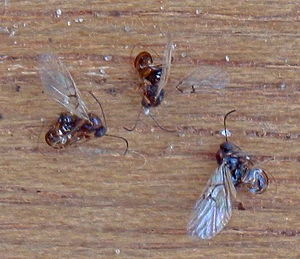
Neuroterus albipes
Encyclopedia
Neuroterus albipes is a gall wasp
that forms chemically induced leaf gall
s on oak trees which has both bisexual and agamic generations and therefore forms two distinct galls, the smooth spangle gall and Schenck's gall. Neuroterus laeviusculus and Spathegaster albipes are previous binomials found in the literature.
. The gall is observed to swell appreciably once it has detached and fallen in late autumn. The gall has also been recorded as green, purple, red or pink.
Schenck's gall is an oval shaped structure, about 0.1 × 0.2 cm and a light green colour, well camouflaged with the leaf lamina. A distinct indentation of the lamina margin is apparent through the inhibition of the normal growth of the leaf by the developing gall; the gall may also appear on the midrib.
Both galls are both unilocular and unilarval.

within the agamic 'smooth spangle gall' generation.
Gall wasp
Gall wasps , also called Gallflies, are a family of the order Hymenoptera and are classified with the Apocrita suborder of wasps in the superfamily Cynipoidea...
that forms chemically induced leaf gall
Gall
Galls or cecidia are outgrowths on the surface of lifeforms caused by invasion by other lifeforms, such as parasites or bacterial infection. Plant galls are abnormal outgrowths of plant tissues and can be caused by various parasites, from fungi and bacteria, to insects and mites...
s on oak trees which has both bisexual and agamic generations and therefore forms two distinct galls, the smooth spangle gall and Schenck's gall. Neuroterus laeviusculus and Spathegaster albipes are previous binomials found in the literature.
Galls
The normally cream coloured saucer of the smooth spangle gall has a small cone elevated in its centre, a pronounced rim and they are sometimes found almost folded in two. The gall may have steaks of purple, red or other colours through it. Typically found on the lower surface, this gall is found more often on the upper surface than other spangle galls and although often grouped together, the numbers on each leaf are far fewer than in species such as Neuroterus quercusbaccarumNeuroterus quercusbaccarum
The common spangle gall on the underside of leaves and the currant gall on the male catkins or occasionally the leaves, develop as chemically induced distortions on pedunculate oak , or sessile oak trees, caused by the cynipid wasp Neuroterus quercusbaccarum which has both agamic and bisexual...
. The gall is observed to swell appreciably once it has detached and fallen in late autumn. The gall has also been recorded as green, purple, red or pink.
Schenck's gall is an oval shaped structure, about 0.1 × 0.2 cm and a light green colour, well camouflaged with the leaf lamina. A distinct indentation of the lamina margin is apparent through the inhibition of the normal growth of the leaf by the developing gall; the gall may also appear on the midrib.
Both galls are both unilocular and unilarval.
Life cycle

Agamic generation
Emerging in spring the female of the agamic generation develops in the discus-shaped structure about 0.4 cm across, known as a 'Smooth Spangle gall'. The gall falls to the ground in autumn, having developed in June or July of the previous summer.Bisexual generation
The females emerge from the smooth spangle gall in early spring and the lay their unfertilised eggs in oak leaves, usually in the margin of the leaf blades, forming the so called 'Schenck's gall.' This second N. albipes gall is hairy to start with and smooth later; not all that obvious and growing as a solitary structure. Schenck's gall produces the bisexual generation in mid-summer and the eggs result in the Smooth Spangle gall generation.Inquilines
The fly Clinodiposis galliperda is often found as an inquilineInquiline
In zoology, an inquiline is an animal that lives commensally in the nest, burrow, or dwelling place of an animal of another species. For example, some organisms such as insects may live in the homes of gophers and feed on debris, fungi, roots, etc...
within the agamic 'smooth spangle gall' generation.
See also
- Neuroterus numismalisNeuroterus numismalisNeuroterus numismalis is a gall wasp that forms chemically induced leaf galls on oak trees. It has both bisexual and agamic generations and forms two distinct galls on oak leaves, the Silk button gall and Blister gall. The galls can be very numerous with more than a thousand per...
- Neuroterus anthracinusNeuroterus anthracinusNeuroterus anthracinus is a widely distributed gall wasp that forms chemically induced leaf galls on oak trees. N. anthracinus has both bisexual and agamic generations and in consequence forms two distinct galls, the oyster gall and April-bud gall. -Synonyms:Ameristus Förster 1869, Diplobius Kinsey...
- Knopper gallKnopper gallAndricus quercuscalicis is a gall wasp species inducing Knopper galls.Knopper galls develop as a chemically induced distortion of growing acorns on Pedunculate Oak trees, caused by gall wasps, which lay eggs in buds with their ovipositor...
- Oak marble gallOak marble gallOak marble galls develop as a chemically induced distortion of leaf buds on pedunculate oak , or sessile oak trees, caused by the parthenogenetic gall wasp which lays eggs within leaf buds using their ovipositor...
- Oak artichoke gallOak artichoke gallOak artichoke galls, oak hop galls, larch-cone galls or hop strobiledevelop as a chemically induced distortion of leaf axillary or terminal buds on Pedunculate Oak or Sessile Oak trees, caused by the parthenogenetic gall wasp Andricus fecundator, which lays single eggs within leaf buds using...
External links
- N. albipes
- Neurotus albipes flies
Sources
- Darlington, Arnold (1975) The Pocket Encyclopaedia of Plant Galls in Colour. Pub. Blandford Press. Poole. ISBN 0-7137-0748-8.
- Stubbs, F. B. Edit. (1986) Provisional Keys to British Plant Galls. Pub. Brit Plant Gall Soc. ISBN 0-9511582-0-1.

